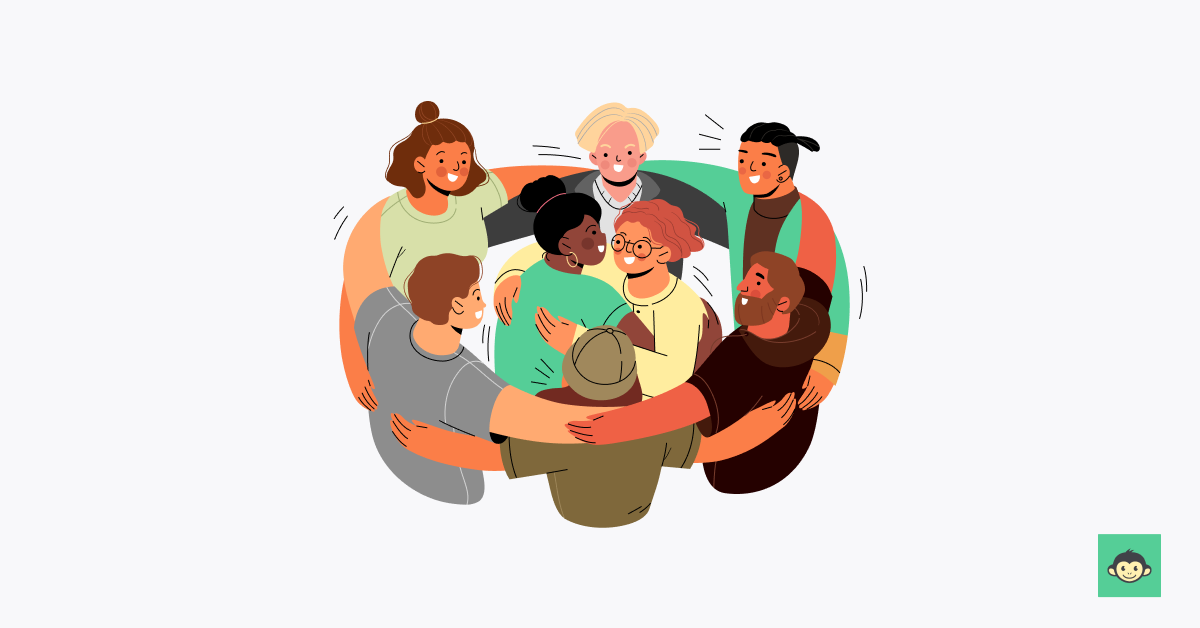How allyship in the workplace can help you create an inclusive workplace: Tips and examples

The concept of allyship has emerged as a powerful force for creating inclusive environments where all individuals can thrive. Allyship goes beyond mere tolerance or passive acceptance of groups together; it embodies active support, advocacy, and solidarity with marginalized groups.
As organizations increasingly recognize the value of diversity and inclusion, cultivating allyship has become essential not only for fostering a sense of belonging but also for driving innovation, creativity, and overall success.
In this blog, we delve into the multifaceted landscape of allyship in the workplace, exploring its significance, principles, challenges, and strategies for implementation.
Allyship in the workplace definition

Allyship in the workplace refers to the practice of individuals, particularly those in positions of privilege and power, actively and empathetically supporting and advocating for their colleagues from marginalized or underrepresented groups.
It goes beyond passive acceptance or tolerance, emphasizing proactive efforts to understand, validate, and address the challenges faced by others.
A workplace ally actively educates themselves about the experiences and issues faced by marginalized groups, seek to understand their own biases, and commits to dismantling systemic barriers. True allyship involves using one's own power and influence to create an inclusive environment, challenging discriminatory practices, and amplifying the voices of those facing adversity.
The key elements of workplace allyship include fostering a culture of respect, actively listening to colleagues' experiences, and leveraging one's influence to promote equity and inclusion.
Allyship is not a one-time act but an ongoing commitment to learning, growth, and advocacy, contributing to the creation of a workplace where individuals of all backgrounds feel valued, supported, and empowered to succeed.
What are the 4 pillars of allyship?

The four pillars of allyship provide a framework for individuals to actively and authentically support marginalized or underrepresented groups in various contexts, including the workplace. These pillars are:
1. Education and awareness
Allyship begins with education and training. Individuals committed to being allies actively seek to understand the experiences, challenges, and histories of women of color and marginalized groups. This involves learning about systemic inequalities, recognizing one's own biases, and staying informed about issues affecting different communities.
2. Listening and empathy
Effective allyship requires active listening and empathetic understanding. Allies create space for open dialogue, validate the experiences of others, support colleagues, and demonstrate a willingness to learn from diverse perspectives. By fostering an empathetic environment, allies build trust and strengthen connections with those they aim to support.
3. Amplification and advocacy
Allies leverage their privilege and influence to amplify the voices of marginalized individuals. This may involve advocating for inclusive policies, addressing bias and discrimination, and actively promoting opportunities for underrepresented groups. Allies use their position to challenge systemic inequities and work towards creating a more equitable environment.
4. Action and accountability
True allyship goes beyond intentions and manifests in concrete actions. Allies actively work towards creating positive change, whether by standing up against discrimination, supporting inclusive initiatives, or championing diversity in decision-making processes.
How do you build allyship at work?

Building allyship at work begins with fostering a culture of inclusion and mutual respect. It starts with education and awareness, where individuals take the initiative to educate themselves about the experiences and challenges faced by marginalized groups.
Actively listening to colleagues' experiences and perspectives is crucial, as it demonstrates empathy and validates their lived experiences.
To build allyship, individuals must use their privilege and influence to amplify the voices of marginalized colleagues and advocate for their inclusion in decision-making processes and opportunities for advancement.
This involves taking concrete actions such as challenging biased practices, supporting diversity initiatives, and speaking up against discrimination.
Moreover, holding oneself and others accountable for creating an effective ally-inclusive environment is essential. By committing to ongoing learning, empathetic listening, advocacy, and accountability, individuals can cultivate allyship at work and contribute to a more equitable and supportive workplace culture.
Organizations can also appoint a chief diversity officer who doesn't focus on his own privilege but on other minority groups, like black women, to promote allyship in the workplace.
Allyship in the workplace activities to try in 2024

In 2024, fostering allyship in the workplace involves implementing actionable initiatives to promote a culture of inclusivity and support. Here are some allyship activities to consider:
- Diversity training and workshops: Conduct regular diversity and inclusion training sessions to educate employees about various perspectives, biases, and the importance of allyship. Workshops can create a shared understanding and language around diversity issues.
- Inclusive language guidelines: Establish and promote guidelines for inclusive language usage in all communications. This helps create a workplace environment where everyone feels respected and valued.
- Intersectionality workshops: Recognize the intersecting identities of individuals by organizing workshops that focus on the unique challenges faced by those with multiple marginalized identities. This deepens understanding and promotes more nuanced allyship.
- Allyship resource groups: Create allyship resource groups or employee resource groups that focus on specific dimensions of diversity. These groups can serve as platforms for education, discussion, and collaborative initiatives.
- Feedback and accountability mechanisms: Establish feedback mechanisms to allow employees to report instances of bias or discrimination. Ensure there are clear accountability measures in place to address such issues promptly.
- Inclusive hiring practices: Review and revise hiring processes to eliminate biases and promote diversity. Implement blind recruitment practices to avoid prioritizing any privileged group and ensure diverse interview panels to reduce unconscious bias.
- Celebrating cultural awareness days: Acknowledge and celebrate cultural awareness days, heritage months, and important diversity-related events. This fosters an appreciation for diverse cultures and backgrounds.
- Leadership training on allyship: Provide training on an allyship program to ensure that organizational leaders are equipped to model inclusive behaviors, champion diversity, and create a supportive workplace culture for women.
- Regular check-ins and surveys: Conduct regular check-ins with employees to assess the effectiveness of allyship initiatives. Use surveys to gather feedback on the workplace climate and identify areas for improvement.
Allyship in the workplace training: Why is it important?
Allyship in the workplace training is crucial for fostering an inclusive and supportive organizational culture. Firstly, it raises awareness about systemic inequities and biases, helping employees understand the experiences of their marginalized colleagues. This shared knowledge forms the foundation for empathetic understanding.
Secondly, training provides practical tools and strategies for individuals to become effective allies, promoting actionable steps for creating a more inclusive environment. Thirdly, it cultivates a culture of accountability by encouraging individuals to challenge discriminatory practices and actively contribute to dismantling barriers.
Ultimately, allyship training is vital for building cohesive teams, reducing unconscious biases, and ensuring that every employee feels valued, heard, and empowered to thrive in the workplace.
7 Ways to be an ally at work as a leader

By embodying the following practices, leaders not only contribute to a more, inclusive workplace culture but also inspire their teams to follow suit. Effective leadership in allyship creates a positive ripple effect, fostering a culture where everyone feels valued and has the opportunity to thrive.
1. Educate yourself and your team
Leaders should take the initiative to educate themselves and their teams about diversity, equity, and inclusion. Stay informed about the experiences of marginalized groups, and encourage ongoing learning through workshops, seminars, and relevant literature.
2. Lead by example
Demonstrate inclusive behaviors by fostering a workplace culture that values diversity. Actively seek and listen to diverse perspectives, and ensure that all team members feel heard and respected.
3. Promote inclusive policies
Advocate for and implement inclusive policies that address bias, discrimination, and systemic barriers. Ensure that company practices actively support diversity and equal opportunities for all employees.
4. Provide mentorship and sponsorship
Support the professional development of individuals from underrepresented groups through mentorship and sponsorship programs. Help them navigate career paths, provide guidance, and advocate for their advancement.
5. Create safe spaces for dialogue
Foster an open and inclusive environment by creating spaces for honest and constructive conversations about diversity and inclusion. Encourage dialogue where team members can share their experiences, challenges, and suggestions for improvement.
6. Challenge biases and microaggressions
Actively address and challenge biases and microaggressions within the workplace. As a leader, set a zero-tolerance policy for discriminatory behavior and model respectful and inclusive communication.
7. Be transparent and accountable
Transparently communicate diversity and inclusion goals, progress, and challenges. Hold yourself and your team accountable for fostering an inclusive company culture, and be open to feedback on areas for improvement.
How can allyship at work solve diversity & inclusion at the workplace?

Allyship at work is a powerful catalyst for addressing and solving diversity and inclusion challenges within the workplace. Firstly, allyship fosters a culture of understanding and empathy by encouraging individuals to educate themselves about the experiences of their colleagues from diverse backgrounds. This awareness reduces ignorance and promotes inclusivity.
Secondly, allies actively advocate for marginalized groups, leveraging their privilege to amplify underrepresented voices and push for inclusive policies. This advocacy is instrumental in dismantling systemic barriers and ensuring equal opportunities for all employees.
Allyship also creates a supportive network that helps individuals navigate workplace challenges, fostering a sense of belonging. By actively challenging biases and discriminatory practices, allies contribute to a more equitable environment, ultimately promoting innovation, collaboration, and a stronger, more cohesive organizational culture centered around diversity and inclusion.
Allyship in the workplace: 4 statistics to know in 2024

- Allyship helps significantly increase retention rates as much so that employees are 50% less likely to leave their organizations.
- Employee performance also increases in inclusive cultures jumping 56%.
- According to a survey by Glassdoor, 61% of employees in the United States believed their companies could do more to improve diversity and inclusion.
- McKinsey reported that companies in the top quartile for ethnic and cultural diversity in executive teams were 36% more likely to achieve above-average profitability.
Role of DEI surveys at work to improve allyship in the workplace

Diversity, Equity, and Inclusion (DEI) surveys play a pivotal role in enhancing allyship in the workplace by providing valuable insights into the experiences of employees. These surveys gauge perceptions of inclusivity, identify areas for improvement, and assess the effectiveness of allyship initiatives.
Through quantitative and qualitative data, organizations can measure the impact of their diversity efforts and tailor allyship programs to address specific needs. DEI surveys also empower employees to express concerns anonymously, fostering a safe space for honest feedback.
By understanding the diverse perspectives within the workforce, organizations can strategically strengthen allyship initiatives, cultivate a more inclusive environment, and ensure that their actions align with the genuine needs and experiences of employees.
Allyship in the workplace examples

Here are a few examples of allyship in the workplace:
Amplifying voices in meetings
Allyship is demonstrated when colleagues actively ensure that everyone's voice is heard in meetings. This includes intentionally giving credit to those whose ideas may be overlooked or interrupted fostering an inclusive environment that values diverse perspectives.
Educational initiatives
Allies engage in and promote educational initiatives, such as workshops or training sessions, to increase awareness and understanding of diversity and inclusion issues. This proactive effort helps create a more informed and empathetic workplace culture.
Intervening against microaggressions
Allies step in when witnessing microaggressions or discriminatory behavior. They address inappropriate comments or actions, fostering a culture where such behaviors are not tolerated and creating a safer space for everyone.
Promoting inclusive hiring practices
Allyship is evident in efforts to advocate for and implement inclusive hiring practices. This may involve pushing for diverse interview panels, combating unconscious biases, and supporting initiatives to attract talent from underrepresented groups.
Conclusion
Allyship in the workplace is the cornerstone of building inclusive, diverse, and thriving professional environments. From amplifying voices and addressing microaggressions to championing educational initiatives and promoting inclusive hiring practices, allyship fosters a culture where individuals feel valued, respected, and empowered.
The examples provided showcase the tangible actions that contribute to dismantling systemic barriers and cultivating workplaces that celebrate diversity. As organizations continue to prioritize allyship, they not only enhance employee well-being but also drive innovation and success.
Allyship is not just a commitment; it's a transformative force that propels workplaces towards true equity and collaboration, ensuring a brighter and more inclusive future.



